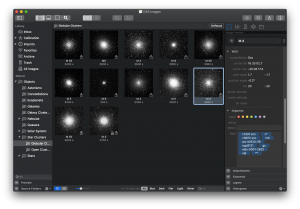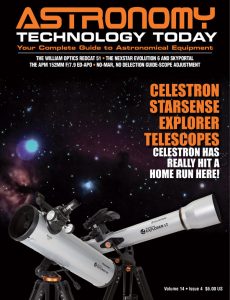Code Obsession has announced the availability of Observatory 1.5.1 which offers an update to its astronomical image management and preprocessing application for macOS.
Observatory is a full-featured native macOS application for image management specifically designed for astronomy. It helps you keep your astronomical images organized with albums, smart albums, tags, ratings and color labels. You can use Observatory to create master bias, dark and flat frames, calibrate, register, stack and adjust your images, all nondestructively. It also provides the ability to add notes, plate solve, have it automatically tag your images, and overlay astronomical catalogs. Observatory even lets you search and download research images directly from over 10 professional image archives.
 Code Obsession’s Observatory integrates with macOS to add Quick Look and Spotlight support for FITS, XISF and SBIG images, making it easier for you to find them and enabling Finder and other applications to display thumbnails, previews and metadata.
Code Obsession’s Observatory integrates with macOS to add Quick Look and Spotlight support for FITS, XISF and SBIG images, making it easier for you to find them and enabling Finder and other applications to display thumbnails, previews and metadata.
The release of Observatory 1.5.1 adds more criteria to smart albums, bringing the total to 33. It also provides enhanced abilities to mix and match criteria such as ISO speed, focal length, detector temperature, exposure time, filter name and rating to organize your images like never before.
Observatory 1.5.1 also provides a number of other updates to its ability for plate solving, automatic tagging and displaying overlays, and helping you identify what’s in your images. It now is even more effective in its ability to nondestructively calibrate, register and stack your images, remove hot pixels, gradients and counter the effects of atmospheric dispersion.
There is now support for camera field rotators. The rotator angle is extracted from images upon importing, and taken into account when calibrating and auto-stacking. This new information is available in the version inspector and as an optional column in the list browser.
Exporting master images has been tweaked a little bit, such that exporting a FITS or SBIG master image with its original dimensions just copies the original file. For managed master images this has always been the case, but now this behavior is also extended to regular masters.
They also fixed a range of smaller issues, such as missing titles and upscaling when exporting to PDF, an issue with opening recent libraries from the Welcome window, a regression that resulted in ESO hierarchical FITS keywords in exported images, and a bug in galaxy overlay position angles.
Code Obsession’s Observatory 1.5.1 is robust in its ability in creating image libraries, rate, add notes and blink images, perform aperture photometry, astrometry, or download research images from the Hubble, Spitzer and WISE Space Telescopes, ESO Science Archive, Palomar Transient Factory, Sloan Digital Sky Survey, SkyMapper Southern Sky Survey, and more.
And if you want to learn more on using Observatory 1.5.1 and other astro imaging software tools, check out the Woodland Hills Telescope and Binoculars latest edition of its YouTube series. The title of this event is “Hardcore Astronomy” and the broadcast dives deep into the software used for astro imaging. Featured are Bob Denny, inventor of the ASCOM standard; Bruce Waddington, a developer with PHD2; and Richard Wright with the Software Bisque SKYX team.
 And to make it easier for you to get the most extensive news, articles and reviews that are only available in the magazine pages of Astronomy Technology Today, we are offering a 1 year magazine subscription for only $6! Or, for an even better deal, we are offering 2 years for only $9. Click here to get these deals which only will be available for a very limited time. You can also check out a free sample issue here.
And to make it easier for you to get the most extensive news, articles and reviews that are only available in the magazine pages of Astronomy Technology Today, we are offering a 1 year magazine subscription for only $6! Or, for an even better deal, we are offering 2 years for only $9. Click here to get these deals which only will be available for a very limited time. You can also check out a free sample issue here.

